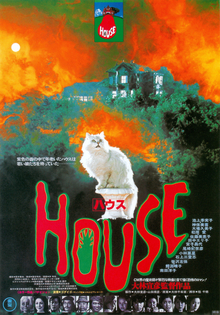MOST BIZARRE MOVIE EVER? MAYBE, BUT IT’S ALSO PURE GENIUS: 1977’S HOUSE
HOUSE (a.k.a. HAUSU)

Pros: Cheerfully deranged and gloriously imaginative = shows the limitless potential of cinema. DVD package is outstanding.
Cons: To say that some people wouldn’t like this movie is putting it nicely
Starting off with a fairly typical haunted house-type story, director Nobuhiko Obayashi’s House (released by the Japanese Toho Studio in 1977) from there ventures out into no man’s land, becoming one of the most wacky films ever produced in the process. Awash with unadulterated creativity, the film makes nary one lick of sense from a typical standpoint, but exists as a truly one-of-a-kind cinematic experience that demonstrates the limitless possibilities of the cinematic medium. Undoubtedly, this movie would not be to all tastes: though a box-office hit upon release in Japan (despite the fact that it is thoroughly un-Japanese), it’s been dismissed by numerous critics over the years and has (admittedly, unsurprisingly) been declared by some to be completely unwatchable . For the select few who would “get” this movie in the first place though, House is a film that makes any and all others look hopelessly dull and a bit pathetic in comparison, a piece that would provide a jolt to the brain of audiences made apathetic by typical Hollywood drivel.

The film begins by introducing the viewer to seven Japanese teenagers who are planning their summer vacation. Each of the girls is identified by their defining characteristic: the smart one is called “Prof,” the chubby girl is “Mac” (short for stomach), the tough girl is known as “Kung Fu,” and so on. The main character here is called “Gorgeous,” who is having problems coming to terms with the fact that her widower father is planning to be remarried. When the girls’ collective vacation plans fall through, Gorgeous invites the gang to join her at a remote mansion owned by her enigmatic aunt. Once the group arrives however, they discover that the aunt’s house itself appears to have an appetite for young girls, and the teens begin to disappear one by one. As the survivors try to figure out a way to escape the estate, Gorgeous begins to discover how similar she and her aunt truly are…

Is that actually the story for this film? In a nutshell, yes, but the House experience is about much more than just the basic storyline which is has to be said is made all but irrelevant by about the five minute mark. In the hands of Obayashi, a director who was known primarily for work in television commercials prior to this feature, House becomes a gleefully gruesome, energetic thrill ride of innovative and playful cinematic technique that resembles what the results might have been had renegade Japanese filmmaker Seijun Suzuki (known for his eccentric crime thrillers) made a horror flick. The script written by Chiho Katsura is little more than a framework which allows Obayashi to let his creative sense run wild and the director winds up unleashing some of the most mind-boggling visuals and sequences ever put to celluloid. The screen is frequently drenched in vivid color or overrun with crude (i.e. purposely imperfect and obviously artificial) but clever special effects, and the pace of the film is simply relentless. Virtually any camera and cinematic technique imaginable is showcased here: we have a truckload of iris effects, split screen sequences, marvelous painted backgrounds combined with live-action foregrounds, chroma key effects, stop-motion, straight-up animation and more. The optical printer certainly gets a workout during the course of this movie, and it leaves one with the notion that Obayashi can’t make it more than a minute without astounding the viewer with some cinematic magic. As wonderful as it is to marvel at all the eye candy though, it’s equally as tempting to focus on the small details, fascinating settings, and constantly evolving backgrounds. There really is a ridiculous amount of amazing things to behold when watching this film.

As may be suggested by that description, it would be easy to point out that this film is entirely incoherent. I’d have to suggest however that viewers who would dismiss House on those grounds are completely missing the point of the film. It’s all but impossible to take this cheerfully demented film seriously on any sort of level, and declaring the wholly dream-like and surrealist piece to be “illogical” is not only stating the obvious but actually a ridiculous statement to make. House is quite clearly told from a young person’s perspective; the result of an imagination running wild and creating scenarios that wouldn’t make any sense to an adult who knows better than to be caught up in fits of fancy. I could easily make a case for this film being a fantasy derived from and taking place in the mind of a young teenager struggling to deal with “real world” or “big people” problems. Gorgeous seems not at all able to truly deal with her mother being “replaced” by the apparently random lover her father has introduced into her life, and many of her seemingly absurd actions in the film appear to the be the result of her unwillingness or inability to come to terms with her situation.

In many ways, I think House was designed for viewing by younger audiences: the film exists as a pop culture nightmare of the type that kids (having been exposed to an endless string of advertisements) would (for better or worse) be accustomed to. Playing as a sort of live-action horror cartoon, House’s editing scheme is extremely manic to the point of resembling the music videos that would turn up a few years after this film’s production, and there’s a noticeable tendency to focus on idiosyncratic detail that most films would gloss over (again, this seems to fall in line with the film being told from a child’s perspective; hell, it might just be the best screen representation of what ADHD feels and looks like). Undoubtedly, the main problem for western audiences is that, in terms of what the majority of American viewers would classify as being acceptable viewing for children, House is way too sexual, violent, and downright subversive. Perhaps it goes without saying that this film defies classification or categorization, but since the film’s ideal target audience would probably have no way of seeing it, it’s not all that surprising that the film has often been misunderstood and marginalized. In the eyes of viewers accustomed to gritty ‘70s cinema like The French Connection, The Exorcist, or even Jaws, House is a true anomaly, a film that was decades ahead of its time when produced and may as well have been beamed in from another dimension.

The actors assembled for this film were mostly amateurs, and it shows since they often seem positively oblivious to what’s going on around them. That said, I think the style suits the material: it would be really hard to swallow this film had the cast been entirely serious about it. All the younger females in the film are spunky and cute in their own way, and established actress Yōko Minamida, who plays the aunt, comes across as being very creepy at times. In terms of the horror movie elements, House takes a while to get going, but eventually unloads some fairly graphic and gory delights. During one scene, one of the girls is attacked by a piano which bites off her fingers and proceeds to devour her whole, and the final third of the film features quite a bit of blood flow and spray. Most of the gore sequences are more tongue-in-cheek amusing than outright horrific, but the film would be fairly shocking to some viewers (and not just because of the carnage). (written by Mickie Yoshino and Asei Kobayashi and performed by Japanese rock group Godiego) is outstanding, continually blaring over any and all action taking place, and Yoshitaka Sakamoto’s photography is actually quite stunning, often shooting from unconventional angles. Finally, I have to commend Toho’s art department for creating some extremely eye-catching and colorful sets – the vast majority of which were constructed in studio. The background paintings seen throughout the film (check out how the skies look in many scenes) are particularly excellent.

At this point, I should point out that this film does have a few minor flaws. For one, I could do without the pointless asides during the final third of the picture which show a male teacher coming to the girls’ rescue. Almost slapstick in nature, these brief scenes take away from the momentum and pure insanity going on back at the titular abode. I’ve also got to say that most of the green screen effects seen in the film look pretty awful. I know I said earlier that the effects here were designed to be imperfect, but there are several scenes in which obvious outlines surround characters and objects, indicating that they’ve been superimposed onto other backgrounds. This is frequently annoying and quite distracting: Toho’s effects team had done better work in the mid-’60s on many of the Godzilla films and I’m not quite sure why they look so horrendous more than a decade later. Remember, Star Wars was made this same year.

I can’t stress enough that House is a film that has to be seen to be believed, one that seems to have inspired a multitude of Japanese films over the years, and one that possibly even led to the country’s enduring fascination with all things pop culture. It’s impossible even for me – a viewer well-versed in the wild worlds of cult films and Japanese cinema – to come up with another film that’s even remotely similar to this, and I’d be lying if I called this film anything less than one of my all time favorites – House has to make at least my top three. Absolutely marvelous in terms of its visuals, House deserves placement among the most artistically and creatively satisfying pieces of cinema ever produced, and I think most any viewer could appreciate that aspect of it even if they don’t like or are confused by the film as a whole. Highly, highly, HIGHLY recommended – this singular classic of Japanese cinema is an absolute must for viewers who enjoy strange and/or cult movies.

A really nice selection of DVD extras – even for a Criterion disc. “Constructing a House” is a rewarding 45-minute featurette in which director Nobuhiko Obayashi, story scenarist Chigumi Obayashi (the director’s daughter), and screenwriter Chiho Katsura discuss and explain the project. The DVD also includes a short appreciation piece with film director Ti West and Nobuhiko Obayashi’s entire, 39-minute and suitably wacky 1966 experimental film Emotion. Picture quality on the disc (original full screen format, in Japanese with English subtitles) is outstanding.
7/10 : A fair amount of gore and extreme violence, but most of it is handled in a comic manner. This is not nearly as rigorous as many of today’s horror films. Weirdness factor is out of the ballpark however.
1/10 : Minimal profanity; some innuendo.
6/10 : Underlying sexual themes exist throughout the film and there’s a decent amount of topless and rear nudity from some cute Japanese girls.
10/10: Is this the most weirdo movie ever? Quite possibly, and it’s also one of the most impressive creative visions ever put to celluloid.
“Just let me eat you…”
TRAILER:


















